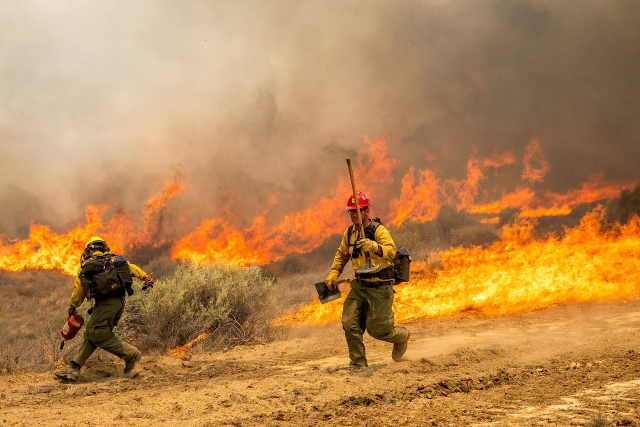
Firefighters scramble to keep the Madre Fire from crossing a dozer line as it makes a run along Highway 166 on Thursday, July 3, 2025, in San Luis Obispo County, California, U.S. (Photo: CFP)
As the United States faces an onslaught of climate-related disasters in 2025, critics say the Trump administration's sweeping public service layoffs and funding cuts are crippling the nation's ability to respond.
The U.S. has already suffered 15 weather-related disasters in the first half of 2025, each causing over $1 billion in damages, according to a July 16 report from reinsurance broker Gallagher Re. From wildfires in California to catastrophic flooding in Texas, natural disasters are escalating while emergency response capacity appears to be declining.
Wildfires outpace federal firefighting capacity
As of July 24, the National Interagency Fire Center reported 63 active large wildfires across the country. More than 38,000 wildfires have scorched nearly 2.9 million acres so far this year, with the western U.S. bearing the brunt.
Yet the federal firefighting workforce is in free fall. More than 4,500 Forest Service firefighting jobs remain vacant as of July 17, a 27% vacancy rate, according to internal data reviewed by ProPublica, a nonprofit newsroom that investigates abuses of power. Meanwhile, the agency's 2,000 probationary employees were terminated in February.
In April, President Trump dismissed seven of the eight members of the Fire Fighter Fatality Investigation and Prevention Program, hampering efforts to analyze and prevent fatal accidents.
A dozen firefighters and personnel involved in federal wildfire response across various agencies described a cascade of additional disruptions under the Trump administration.
Hiring for seasonal workers has stalled. Funding for nonprofit partners conducting fuel-reduction projects has been frozen. Crews deployed for prescribed burns in Florida were abruptly turned back, while teams working on wildfire cleanup in California reported confusion over how long they would be allowed to remain on the job.
Flood response bottlenecked by bureaucracy
The damage is not limited to wildfires. Climate-fueled storms and floods are also surging, and the nation's capacity to respond is under strain.
In April, historic rainfall in the Mississippi River Valley triggered flash floods, killing at least 24 people. In early July, Texas experienced one of its deadliest floods in recent history, leaving at least 137 dead. AccuWeather estimates the floods caused $18 to $22 billion in damages.
But the Federal Emergency Management Agency (FEMA), which leads flood response, has been hamstrung by internal bureaucracy and downsizing.
Aimed at cutting spending, Homeland Security Secretary Kristi Noem—whose department oversees FEMA—now requires her personal approval for all FEMA contracts and grants above $100,000, delaying even smaller disbursements and slowing response times.
FEMA's request for aerial imagery to aid rescues in Texas, for example, was delayed due to pending approval from Noem's office.
The agency itself has been gutted. Following Trump's dismissal of acting FEMA administrator Cameron Hamilton, new appointee David Richardson reportedly told staff that anyone obstructing the president's directives would be "run right over."
Sixteen senior FEMA officials resigned in May following Richardson's appointment. Since Trump's second term began, an estimated 2,000 employees have left the agency through resignations or retirements, raising alarms about FEMA's capacity to respond to what experts warn will be an increasingly devastating storm season.
In a moment that stunned longtime staff, Richardson reportedly admitted during a leadership briefing that he was unaware hurricane season had already begun.
The National Oceanic and Atmospheric Administration (NOAA), which provides critical storm tracking and forecasting, has also faced steep cuts. In February, about 800 employees across NOAA's departments were laid off, impairing real-time disaster monitoring and modeling efforts.
The rich get richer, the disasters get deadlier
Critics argue that Trump's deep cuts to emergency services are part of a broader pattern: slashing government programs that benefit vulnerable populations while prioritizing the wealthy.
"Just look at what happened in Texas. Trump gutted the very departments that could have saved lives," said Harvey Dzodin, former legal adviser in the Carter administration and former director and vice president of ABC Television in New York. "Then he shifted billions in tax cuts to millionaires and billionaires through his One Big Beautiful Bill, while stripping over $1 trillion from Medicaid and food assistance."
Emergency management expert Samantha Montano said the consequences of gutting key disaster response agencies are dire and escalating.
"If the cuts continue, we will be seeing higher death tolls and more devastation, absolutely," Montano said. "It's beyond crazy that we are eliminating the funding for these agencies, particularly at this moment when hazards are increasing because of climate change."
Co-presented by South and the School of Journalism and Communication, Jinan University
Reporter | Liu Xiaodi, Chen Sihan (intern)
Editor | Yuan Zixiang, James, Shen He

















